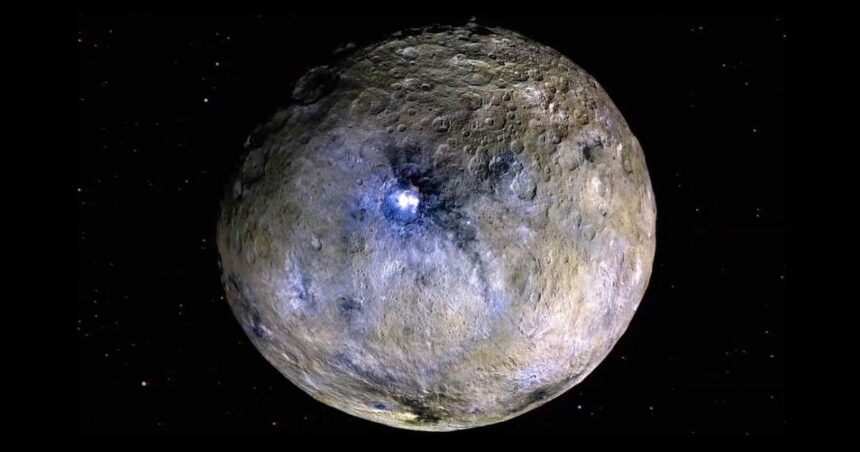Scientists made an exciting discovery about a nearby dwarf planet. They found that its crust could be made up of 90% water! This dwarf planet, called Ceres, is the largest object in the asteroid belt between Mars and Jupiter. It’s a fascinating place that could teach us a lot about ocean worlds and what they look like when they freeze over.
Ceres: A Unique Dwarf Planet
Ceres was first discovered in 1801 and is sometimes called an asteroid because of where it is in the Solar System. But it’s big and round enough to be classified as a dwarf planet, just under half the size of Pluto. It’s also quite unique. It’s the only dwarf planet closer to the Sun than Neptune, and it has bright spots on its surface that might be made of ice.
Scientists from Purdue University and NASA’s Jet Propulsion Laboratory (JPL) used computer simulations to study Ceres. They found that its crust is likely made up of about 90% ice near the surface. This is much more than the previously estimated 30%. The researchers think that there’s a lot of water-ice near Ceres’s surface, and it gets less icy as you go deeper.
Importance of the Discovery
This discovery is important because it helps us understand more about Ceres and other similar objects in the Solar System. Ceres’s surface is heavily cratered and scarred, which made scientists think it wasn’t very icy. But the new research shows that it could have a lot of ice near the surface, making it an interesting place to study.
Ceres’s bright spots are another mystery that scientists are trying to solve. These spots might be the remnants of a frozen ocean that once existed on the dwarf planet. Studying these bright spots could give us more clues about Ceres’s history and how it has changed over time.
The discovery of Ceres’s icy crust also has implications for our understanding of other ocean worlds in the Solar System. By studying Ceres, scientists can learn more about how icy worlds evolve and what they might look like. This information could be useful for future missions to other icy moons and planets.
Ceres is also an important target for future exploration. Its icy crust and potential for water make it a good candidate for studying the possibility of life beyond Earth. If there is water on Ceres, it could provide clues about the conditions needed for life to exist.
In conclusion, the discovery that Ceres’s crust could be 90% water is a significant finding. It helps us understand more about this unique dwarf planet and other similar objects in the Solar System. By studying Ceres, scientists can learn more about icy worlds and their potential for hosting life. This discovery opens up new possibilities for future exploration and research.
The findings from Ceres are a reminder of the vast, unexplored mysteries within our own Solar System. This dwarf planet, with its potentially water-rich crust, offers an incredible opportunity for scientists to delve into the history and evolution of icy worlds. The bright spots on its surface, likely remnants of a once-active ocean, only add to the intrigue and the potential for groundbreaking discoveries.
The implications of water-ice near Ceres’s surface are profound. Not only does it challenge previous assumptions about the composition of dwarf planets in the asteroid belt, but it also provides a tantalizing possibility for future manned missions. The presence of water-ice could be crucial for sustaining life, making Ceres an invaluable asset for future space exploration missions.
The role of Ceres in the broader context of planetary science cannot be overstated. As one of the largest bodies in the asteroid belt, its study could provide critical insights into the early Solar System. Scientists are eager to continue their research, utilizing more advanced tools and techniques to uncover the mysteries hidden beneath its icy crust.
As we look forward to the future, the exploration of Ceres could serve as a stepping stone for missions to other distant icy worlds. Each discovery adds another piece to the puzzle, bringing us closer to understanding the origins of our Solar System and the potential for life beyond Earth.




